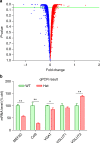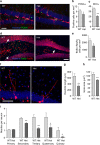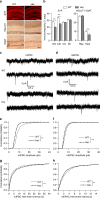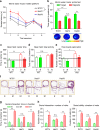NitroSynapsin therapy for a mouse MEF2C haploinsufficiency model of human autism
- PMID: 29133852
- PMCID: PMC5684358
- DOI: 10.1038/s41467-017-01563-8
NitroSynapsin therapy for a mouse MEF2C haploinsufficiency model of human autism
Abstract
Transcription factor MEF2C regulates multiple genes linked to autism spectrum disorder (ASD), and human MEF2C haploinsufficiency results in ASD, intellectual disability, and epilepsy. However, molecular mechanisms underlying MEF2C haploinsufficiency syndrome remain poorly understood. Here we report that Mef2c +/-(Mef2c-het) mice exhibit behavioral deficits resembling those of human patients. Gene expression analyses on brains from these mice show changes in genes associated with neurogenesis, synapse formation, and neuronal cell death. Accordingly, Mef2c-het mice exhibit decreased neurogenesis, enhanced neuronal apoptosis, and an increased ratio of excitatory to inhibitory (E/I) neurotransmission. Importantly, neurobehavioral deficits, E/I imbalance, and histological damage are all ameliorated by treatment with NitroSynapsin, a new dual-action compound related to the FDA-approved drug memantine, representing an uncompetitive/fast off-rate antagonist of NMDA-type glutamate receptors. These results suggest that MEF2C haploinsufficiency leads to abnormal brain development, E/I imbalance, and neurobehavioral dysfunction, which may be mitigated by pharmacological intervention.
Conflict of interest statement
The authors declare that S.A.L. is the inventor on worldwide patents for the use of memantine and NitroSynapsin for neurodegenerative and neurodevelopmental disorders. Per Harvard University guidelines, S.A.L. participates in a royalty-sharing agreement with his former institution Boston Children’s Hospital/Harvard Medical School, which licensed the drug memantine (Namenda®) to Forest Laboratories, Inc./Actavis/Allergan, Inc. The remaining authors declare no competing financial interests.
Figures








Similar articles
-
MEF2C Hypofunction in Neuronal and Neuroimmune Populations Produces MEF2C Haploinsufficiency Syndrome-like Behaviors in Mice.Biol Psychiatry. 2020 Sep 15;88(6):488-499. doi: 10.1016/j.biopsych.2020.03.011. Epub 2020 Mar 31. Biol Psychiatry. 2020. PMID: 32418612 Free PMC article.
-
Dysregulation of miRNA expression and excitation in MEF2C autism patient hiPSC-neurons and cerebral organoids.Mol Psychiatry. 2025 Apr;30(4):1479-1496. doi: 10.1038/s41380-024-02761-9. Epub 2024 Sep 30. Mol Psychiatry. 2025. PMID: 39349966 Free PMC article.
-
Peripheral Auditory Nerve Impairment in a Mouse Model of Syndromic Autism.J Neurosci. 2022 Oct 19;42(42):8002-8018. doi: 10.1523/JNEUROSCI.0253-22.2022. Epub 2022 Sep 30. J Neurosci. 2022. PMID: 36180228 Free PMC article.
-
The molecular basis of memantine action in Alzheimer's disease and other neurologic disorders: low-affinity, uncompetitive antagonism.Curr Alzheimer Res. 2005 Apr;2(2):155-65. doi: 10.2174/1567205053585846. Curr Alzheimer Res. 2005. PMID: 15974913 Review.
-
MEF2C haploinsufficiency syndrome: Report of a new MEF2C mutation and review.Eur J Med Genet. 2016 Sep;59(9):478-82. doi: 10.1016/j.ejmg.2016.05.017. Epub 2016 May 31. Eur J Med Genet. 2016. PMID: 27255693 Review.
Cited by
-
Therapeutic efficacy of novel memantine nitrate MN-08 in animal models of Alzheimer's disease.Aging Cell. 2021 Jun;20(6):e13371. doi: 10.1111/acel.13371. Epub 2021 May 6. Aging Cell. 2021. PMID: 33955647 Free PMC article.
-
NitroSynapsin ameliorates hypersynchronous neural network activity in Alzheimer hiPSC models.Mol Psychiatry. 2021 Oct;26(10):5751-5765. doi: 10.1038/s41380-020-0776-7. Epub 2020 May 29. Mol Psychiatry. 2021. PMID: 32467645 Free PMC article.
-
A Synaptic Perspective of Fragile X Syndrome and Autism Spectrum Disorders.Neuron. 2019 Mar 20;101(6):1070-1088. doi: 10.1016/j.neuron.2019.02.041. Neuron. 2019. PMID: 30897358 Free PMC article. Review.
-
Identification of 371 genetic variants for age at first sex and birth linked to externalising behaviour.Nat Hum Behav. 2021 Dec;5(12):1717-1730. doi: 10.1038/s41562-021-01135-3. Epub 2021 Jul 1. Nat Hum Behav. 2021. PMID: 34211149 Free PMC article.
-
Early Signs of Molecular Defects in iPSC-Derived Neural Stems Cells from Patients with Familial Parkinson's Disease.Biomolecules. 2022 Jun 23;12(7):876. doi: 10.3390/biom12070876. Biomolecules. 2022. PMID: 35883433 Free PMC article.
References
Publication types
MeSH terms
Substances
Grants and funding
LinkOut - more resources
Full Text Sources
Other Literature Sources
Molecular Biology Databases

